All Posts (6509)
| Image Source: Giant Magellan Telescope Organization |
Topics: Astronomy, Astrophysics, Diversity in Science, Research
In the spirit of full disclosure, my apologies for missing this last month. I happened upon it at UT Austin's website looking for something else completely. A happy find!
Pasadena, CA – November 16, 2016 – The Giant Magellan Telescope Organization (GMTO) today announced the appointment of Walter E. Massey, PhD, and Taft Armandroff, PhD, to the positions of Board Chair and Vice Chair, respectively. Continuing their involvement in new leadership capacities, Massey and Armandroff will guide the GMTO Board, overseeing the construction of the 24.5 meter Giant Magellan Telescope (GMT) in the Chilean Andes and working to complete the partnership of universities, research institutions and private donors who will contribute to the construction and operation of the GMT.
Poised to be the first of a new generation of extremely large telescopes, the GMT will be the largest optical telescope in the world when it comes online in 2022. The project is a distinguished collaboration of US institutions and international partners from Australia, Brazil and Korea. The telescope will be constructed at Las Campanas Observatory in Chile.
“With his exceptional leadership and wisdom Dr. Massey will guide the GMTO Board with a steady hand as the telescope moves through the construction phase,” said Nobel Laureate Prof. Brian Schmidt, Vice Chancellor of the Australian National University. “Dr. Massey has an outstanding record of enabling breakthrough science through stewardship of major research facilities, including the Laser Interferometer Gravitational-Wave Observatory (LIGO).”
Armandroff serves as the director of The University of Texas at Austin’s McDonald Observatory and as a Professor in the Department of Astronomy. Prior to this, Armandroff was Director of the W. M. Keck Observatory in Hawaii for eight years. During his leadership there, the two 10-meter Keck telescopes played a key role in many astronomical discoveries. Armandroff also worked as an astronomer and eventually Associate Director for 19 years at the National Optical Astronomy Observatory (NOAO) in Tucson, Ariz. After a successful year as GMTO Board Chair, he will be stepping into the Vice Chair position, where he will partner with Massey to lead the Board as it advances the GMT through construction.
McDonald Observatory, University of Texas at Austin:
Walter E. Massey and Taft Armandroff Selected to Lead Giant Magellan Telescope Board of Directors
 |
| Image Source: Symmetry Magazine, Credit: Noemi Caraban, SESAME |
Topics: High Energy Physics, Theoretical Physics, Research
I guess one miracle is where it's located and WHO will be a part of it, proving at least in the science world we can all play together in the same sandlot.
Primer on synchrotrons here.
When fully operational, the facility in Allan, Jordan, called SESAME, will mark a major victory for science in the region and also for its international backers. Like CERN, SESAME was established under the auspices of UNESCO, but it is now an independent intergovernmental organization and aims to facilitate peace through scientific collaboration that might supersede political divisions. Countries and labs the world over have responded to that vision by contributing to SESAME’s design, instrumentation and construction.
SESAME, which stands for The Synchrotron-light for Experimental Science and Applications in the Middle East, is a 133-meter circumference storage ring built to produce intense radiation ranging from infrared to X-rays, given off by electrons circling inside it at high energies. At the heart of SESAME are injector components from BESSY I, a Berlin-based synchrotron that was decommissioned in 1999, donated to SESAME and upgraded to support a completely new 2.5-GeV storage ring. With funding provided in part by the European Commission and construction led by CERN in collaboration with SESAME, the new ring is on par with most modern synchrotrons.
Over the past decade, SESAME has organized regular users meetings each year to discuss and develop proposed research plans. That community is now over 200 strong. The international facility hosts members from Bahrain, Cyprus, Egypt, Iran, Israel, Jordan, Pakistan, the Palestinian Authority and Turkey.
Symmetry Magazine: SESAME to open in 2017, Troy Rummler
Clarke's world, named after Arthur C. Clarke, is accepting submissions from all authors and they pay up to $1,380 per published short. Make sure to read what they won't print (i.e., sparkly vampires) before you submit. They accept horror, SF, & fantasy. Their direct link is below.
Good luck to all of you.
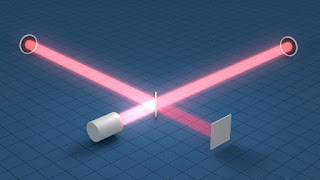 |
| Image Source: LIGO.Caltech.edu/detection |
Topics: Einstein, General Relativity, Gravitational Waves, Research, Theoretical Physics
The Physics World 2016 Breakthrough of the Year goes to "the LIGO Scientific Collaboration for its revolutionary, first-ever direct observations of gravitational waves". Nine other achievements are highly commended and cover topics ranging from nuclear physics to material science and more.
Almost exactly 100 years after they were first postulated by Albert Einstein in his general theory of relativity, gravitational waves hit the headlines in 2016 as the US-based LIGO collaboration detected two separate gravitational-wave events using the Advanced Laser Interferometer Gravitational-wave Observatory (aLIGO). The first observation was made on 14 September 2015 and was announced in February this year. A second set of gravitational waves rolled through LIGO's detectors on 26 December 2015, and this so-called "Boxing Day event" was announced in June this year. Gravitational waves are ripples in the fabric of space–time, and these observations mark the end of a decades-long hunt for these interstellar undulations.
The measurements also herald the start of the era of gravitational-wave astronomy and multi-messenger astronomy, whereby gravitational-wave observations are combined with those made by optical and radio telescopes and other detectors observing the cosmos. Indeed, LIGO's twin detectors will soon be joined by a global network of gravitational-wave detectors.
The top 10 breakthroughs were chosen by a panel of four Physics World editors and reporters, and the criteria for judging included:
- fundamental importance of research;
- significant advance in knowledge;
- strong connection between theory and experiment; and
- general interest to all physicists.
Physics World:
LIGO's gravitational-wave discovery is Physics World 2016 Breakthrough of the Year
In the ancient scriptures of both vampire and witch religions, a fallen angel named Azazel fell in love with a human named Lilith. Azazel opened Lilith’s mind to its full potential, giving her magical abilities which made her the first witch. Living together in bliss for centuries, Lilith gave birth to Azazel’s child, Dracule. To her horror, Dracule was cursed with an insatiable craving for human blood, becoming the first vampire. Feeling that this was a result of their forbidden mating, Lilith abandoned Azazel and Dracule to go out and explore the world. As Dracule reached adulthood, the angels observed that he had begun to transform more humans into vampires. For bringing this curse into the world, Azazel was banished from the mortal plain. In his absence, he left a book of scriptures called “The Book of Azazel” to govern over Dracule and his growing race of vampires. Still bitter from abandonment, Dracule discovered that Lilith had gone out into the world and shared her magical gifts with other humans, creating more witches as her new family. Enraged at her rejection of him and accepting of others, Dracule pronounced the existence of witches an abomination and declared war on all of their kind. To create protectors for her people, Lilith used her power to mix the blood of a vampire with the blood of a wolf to be ingested by humans. This created the first werewolves. In an effort to draw the wrath of Dracule away from the witches, Lilith disappeared from her coven but left them with a set of scriptures called “The Book of Lilith”, to help guide them in her absence. The sudden disappearance of Lilith caused Dracule to abandon his army and follow her into the unknown, never to be seen again.
The loss of their leader only increased the vampire’s war with the witches and their werewolf, slave soldiers. After centuries of war, scriptures from both religions brought the vampires and witches to the prophesized holy land of Salem in the new world. In the newly settled town, a war is waged between vampire, witch, werewolf and human over ownership of the land. As the son of the witches’ coven queen, Amelia, falls in battle, she sends for a young scientist named Dr. Victor Frankenstein. He had become world renown for tales of his resurrection procedures. Shortly after his arrival in Salem, Dr. Frankenstein constructed a new resurrection machine that combined his technology with the witches’ magic. After activating the machine, it not only revived Amelia’s son, but also opened an interdimensional portal that released powerful chaotic energy that threatened to destroy the entire town. Just then, a mysterious warlock suddenly arrived on the scene and used his great power to contain the rampaging energy back into the machine. The warlock then gathered the races of Salem and introduced himself as “Artorus”. He then presented the vampires with the more enlightened new testament of the Book of Azazel, as was prophesized in their old testament scripture. Artorus told the people that he had been sent by the newly enlightened Azazel from beyond to bring peace to Salem. He informed them all that the energy released from Dr. Frankenstein’s machine was the eternal light of the holy land prophesized by both vampire and witch scriptures. Artorus continued to further explain that now with the stabilized life energy emitting from the machine throughout Salem, that no supernatural beings would ever crave to feed again as long as they resided on Salem lands. Then turning his attention to the humans, Artorus told them that by coming directly into the machines’ presence, they would become immortals like the supernaturals.
Having gained respect from the different factions with his great power and knowledge, Artorus struck a peace treaty amongst the races. He both convinced the witches to free their werewolf slaves, as well as have the humans accept the supernaturals since they no longer needed to feed. Incorporating rules from the various religions, the races formed laws for a Salem secret government and established individual territories within the town. To enforce the laws of the new government, Artorus chose seven anointed soldiers he dubbed, “The Reckoning”, that consisted of every race of Salem. He equipped them with seven amulets connected to his own power that would increase the Reckoning’s individual abilities tenfold. After decades of peace in Salem, as the secret society stayed hidden from outsiders, Artorus and The Reckoning disappeared from the town. Artorus left only a prophecy of their return in the time Salem’s greatest need.
Centuries later, Salem has continued to thrive. Now grown from small town into the metropolis of “New Salem”, the politics and beliefs within the city have greatly evolved. Dr. Frankenstein, now going by, Dr. Vincent Ericstein, has brought a scientific revolution to the city with his many secret technological breakthroughs. With advances such as his psychic “Telenet”, which connects the minds of all of New Salem’s citizens, as well as the high tech weaponry used by the New Salem Secret Police, order has been kept in the ever evolving secret society. Even more transformative, has been Dr. Ericstein’s “Evolutional Supernatural Theory”. In his theory, he explains that witches are just telepathic humans with various psychic abilities. He also explains vampires and werewolves as the result of highly evolved predatory viruses, that have formed symbiotic bonds with human hosts. Following his scientific movement, the younger generations of the different New Salem factions have begun to reject the rules of the old religions and started to integrate their cultures.
With the age of enlightenment continuing to grow, the citizens of New Salem’s secret society have grown weary of the restrictions living in hiding has placed on them and seek the government’s approval to expose their existence to the rest of the world. But not everyone has looked favorably upon this revolution. A growing terrorist organization known as, “The Red Circle”, have sought to preserve the ways of the old supernatural religions by committing random massacres on the civilian populace and threaten to cause a war with the outside human world if New Salem’s government approves exposure. Though the government has tried to stop them, they’ve found their forces to be no match for the mysterious power of the Red Circle. Now trying to disrupt the paralyzing religious influence of the Red Circle as well as the manipulations of his grandfather on the city government, young scientist Christian Ericstein has sought out to contact the long missing Artorus. Christian plans to bring Artorus back to the city to assemble a new Reckoning to destroy the Red Circle and maintain the balance between old religious beliefs and the modern laws of the government. As a scientist, Christian strictly believes in pure logic, but after being witness to some of Artorus unexplainable abilities upon his return, he has begun to question whether there’s more of a connection between science and religion.
I finally took a busman's holiday and built my own web site. All my writing is now in one place. There is stuff you can read for free and stuff you can buy.
Keep in mind that the more stuff you buy the happier I am and this is the season to spread joy. Not to be pushy, I'm just sayin'.
Brittle Riders Teaser from Bill McCormick on Vimeo.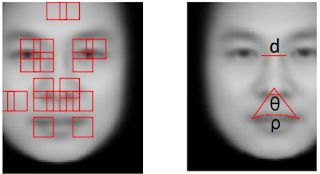 |
| Image Source: Link below |
Topics: Artificial Intelligence, Commentary, Politics, Science Fiction, Research
In the science fiction short story and 2002 film "Minority Report" (also a short-lived series with Megan Good), by the legendary Philip K. Dick, using psychics (you can get away with that in science fiction) as "PreCogs," they could apprehend citizens guilty of "PreCrime." In other words before you even THINK you're going to commit a crime, you are guilty before proven innocent. I guess civil liberties go out the window in 2054.
One part of this report gave me some pause:
With the advent of photography, a tiny fraction of 19th-century scientists believed they could develop methods of accurately identifying criminals by their facial features. While their hypotheses were eventually discredited, new artificial intelligence technology suggests their claims might’ve been valid after all.
Xiaolin Wu and Xi Zhang from Shanghai Jiao Tong University in China have resurrected this facial recognition tradition and built a neural network that can supposedly pick out criminals by simply looking at their faces.
To accomplish this, the researchers used an array of machine-vision algorithms to examine a series of facial juxtapositions between photos of criminals and non-criminals with the goal of finding out whether a neural network can reliably tell them apart.
As MIT Technology review explains, there are three defining facial features the neural network factored in to make its classifications:
[T]he curvature of upper lip which is on average 23 percent larger for criminals than for noncriminals; the distance between two inner corners of the eyes, which is 6 percent shorter; and the angle between two lines drawn from the tip of the nose to the corners of the mouth, which is 20 percent smaller.
I might have such an upper lip, as may many other ethnicities.
Artificial intelligence like its original biological intelligence model could be taught by condition and repetition: biased prejudice in service of the state.
The Next Web:
This scary artificial intelligence has learned how to pick out criminals by their faces
by Mix
One of two breaks in December, the second around Christmas/Hanukkah/Kwanzaa. See you for this one the 12th.
Hey guys! My name is Beverly and I am looking for a little holiday help through offering commissions. below is an image showing my rates. If you are looking for a fun stylized piece of art this holiday season, please consider commissioning me :)
Also feel free to look at my other work so you can have an idea of what you will receive here: http://theshatteredworld.com
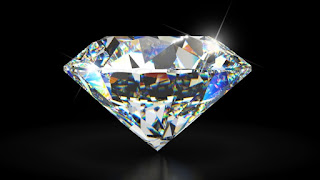 |
| Image Source: Entrepreneur.com, a similar photo is also at the link below. |
Topics: Condensed Matter Physics, Nuclear Physics, Nuclear Power
Well, not exactly forever, but at least past our lifetimes.
Scientists from the University of Bristol Cabot Institute are hitting two birds with one stone, thanks to their lab-made diamond that can generate electricity and is made from upcycled radioactive waste.
In nuclear power plants, radioactive uranium is split in a process called nuclear fission. When the atoms are split, heat is generated, and that heat then vaporizes water into steam that turns electricity-generating turbines.
A severe downside of this process is the creation of dangerous radioactive waste, which ultimately deposits in the graphite core that it is housed in. Today, this nuclear contamination is safely stored away until it stops being radioactive…and with a half-life of 5,730 years, that takes quite a while.
The scientists found a way to heat the radioactive graphite to release most of the radioactivity in a gaseous form. The gas is subjected to high temperature and low pressures that turn it into a man-made diamond.
Futurism:
Diamond Batteries Made of Nuclear Waste Can Generate Power For Thousands of Years
Author: Jess Vilvestre, Editor: Patrick Caughill
For Black History Month in Feb. www.horroraddicts.net are looking for submissions of blogs, essays and articles about the black experience in horror. For details you can email horroraddicts@gmail.com or contact the editor Stacy Rich on their face book page
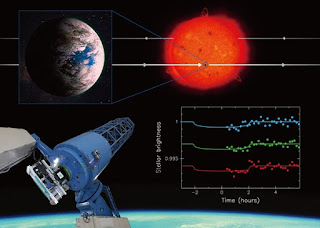 |
| A collage that summarizes the research NAOJ |
Topics: Astronomy, Astrophysics, Exoplanets, NASA, Space Exploration
Researchers from the National Astronomical Observatory of Japan (NAOJ), the University of Tokyo, and the Astrobiology Center have nailed down an important property of a potentially Earth-like extrasolar planet while it was in transit.
The team used the MuSCAT instrument on the Okayama Astrophysical Observatory’s 188-cm telescope to study the extrasolar planet, called K2-3d, discovered by NASA’s Kepler spacecraft in 2015.
The extrasolar planet is about 150 light-years away, 1.5 times the size of Earth, and closely orbits its host star in about 45 days. K2-3d is particularly important to scientists because there’s a chance it may foster extraterrestrial life. Calculations show that the temperature of the host star and the closeness of the orbit make for a warm Earth-like climate with the possibility of liquid water on the surface.
Astronomy: An Earth-like extrasolar planet could harbor extraterrestrial life
Nicole Kiefert
The Priestess Second Saga returns! Little Fish and the Aesir Witch Mjarga come ashore to a land dominated by a great palm tree forest. On the horizon they see the ragtag survivors of the 'Everstorm' approaching. There is good reason to rejoice, but Little Fish is concerned. How will the people of Aesirfjord react to near centuries younger Mjarga? Most worrisome is whether or not he managed to reach the place in the vision of where the army threatening the Priestess when his father the Valley Knight moves against them?
Unknown to the new arrivals, others arrived in the nation of Palm long before they have. Will those survivors of the Everstorm turn out to be friend or foe? Will they find the Valley Knight in time to help him save the Priestess? All these questions and much more will be answered Monday, November 28th in 'The Priestess Second Saga: Stones, Love and Betrayal!'
 |
| Image Source: Capital Hill Blue |
Topics: Commentary, Politics, Research, Science, SETI
In our national mythology, we attribute all-wisdom, all-knowledge and all-prescience to the Founding Fathers. However, certain things they could not have predicted: an electorate made up of the plurality of voluntarily registered voters and not just property owners, the freedom of slaves and their rights as citizens, including the vote; women having the right to vote, an African American president, the removal of what used to be referred to as "bungholery" at least in spirit from the Uniform Code of Military Justice as well as public life; a credible female candidate of a national party and the Internet. Obviously crafting the First Amendment, they envisioned a free press and a public education system that would at least inform the citizenry. They had no concept of corporate conglomerates (or corporations), Nielsen Ratings, talk radio, created realities; the triangulation of church, state and echo chamber; social media or click-bait.
Post-Truth: ADJECTIVE
Relating to or denoting circumstances in which objective facts are less influential in shaping public opinion than appeals to emotion and personal belief:
‘in this era of post-truth politics, it's easy to cherry-pick data and come to whatever conclusion you desire’
‘some commentators have observed that we are living in a post-truth age’
NPR All Tech Considered:
We Tracked Down A Fake-News Creator In The Suburbs. Here's What We Learned
Don't forget to turn your scales back ten pounds this weekend...
 |
| davidope for Quanta Magazine |
Topics: Biology, Neuroscience, Quantum Computer, Quantum Mechanics
Note: With the exception of the historical links below, I don't have anything related to physics and Thanksgiving. Enjoy the food and links. Travel safe.
The mere mention of “quantum consciousness” makes most physicists cringe, as the phrase seems to evoke the vague, insipid musings of a New Age guru. But if a new hypothesis proves to be correct, quantum effects might indeed play some role in human cognition. Matthew Fisher, a physicist at the University of California, Santa Barbara, raised eyebrows late last year when he published a paper in Annals of Physics proposing that the nuclear spins of phosphorus atoms could serve as rudimentary “qubits” in the brain — which would essentially enable the brain to function like a quantum computer.
As recently as 10 years ago, Fisher’s hypothesis would have been dismissed by many as nonsense. Physicists have been burned by this sort of thing before, most notably in 1989, when Roger Penrose proposed that mysterious protein structures called “microtubules” played a role in human consciousness by exploiting quantum effects. Few researchers believe such a hypothesis plausible. Patricia Churchland, a neurophilosopher at the University of California, San Diego, memorably opined that one might as well invoke “pixie dust in the synapses” to explain human cognition.
Quanta Magazine: A New Spin on the Quantum Brain, Jennifer Ouellette
Completely unrelated to anything but the day:
Manataka American Indian Council on Thanksgiving
What Really Happened at the First Thanksgiving? The Wampanoag Side of the Tale
Gale Tourey Toensing
Topics: Bose-Einstein Condensate, Gravity, Nanotechnology, Quantum Mechanics, Semiconductor Technology
A new sensor that measures the local acceleration due to gravity using a Bose–Einstein condensate (BEC) of ultracold atoms has been made by physicists in Germany, the US and Canada. While the prototype device is not as accurate as commercial gravimeters, its makers say it could be made much smaller and much more accurate than existing devices.
Atoms can be used to measure the acceleration due to gravity by cooling a gas of them to near absolute zero and then dropping them along two different paths in an interferometer. The quantum interference that occurs when the paths converge at a detector provides a very good measure of gravity, with commercial atom interferometers able to measure the acceleration to within one part in 108. Such measurements are invaluable for geological exploration because the presence of certain minerals can be spotted by seeking tiny variations in gravity at the Earth's surface.
While these ultracold atom gravimeters are on a par with conventional absolute gravimeters based on macroscopic falling masses, their accuracy could be improved a lot by using a BEC. In a conventional atomic gravimeter, the ultracold atoms form a diffuse gas roughly a millimetre in size and a major cause of uncertainty is that the laser pulses used to control the atoms are not spatially uniform on that length scale. A BEC – formed by cooling a gas of atoms with integer spin until they condense into a single quantum state – reduces this uncertainty because it squeezes the atoms into a region that is about 100 times smaller.
Physics World: Gravity measured using a Bose–Einstein condensate on a chip
Hamish Johnston
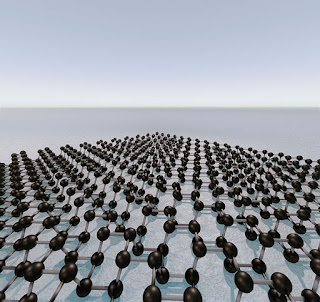 |
| Phosphorene is a graphene-like material that is a hot research topic, according to a new study. (Courtesy: Robert Brook/Science Photo Library) |
Topics: Dark Matter, Materials Science, Neutrinos, Research
China is performing "outstanding" research in a number of emerging scientific topics, putting the country's output on a par with the UK but still behind the US. That is the conclusion of a new study by the Chinese Academy of Sciences (CAS) and the scientific data company Clarivate Analytics. The Research Fronts 2016 annual report identifies 100 "hot" and 80 "emerging" research areas based on citation analysis of papers published in 2015.
The research areas – divided in various fields of science – reflect global interest in specific topics that have resulted in "core" journal articles. These articles are defined by an algorithm that takes into account, among other things, the time of publication and how frequently an article is cited by other papers in the same area. In physics, for instance, the hottest research pursuits last year included the detection of dark matter and experiments that measure neutrino oscillations. Research into properties and applications of black phosphorus – a 2D material also called phosphorene because of its similarity to graphene – was also identified. The study of topological materials called Weyl semimetals was also named as a hot topic in physics.
Six countries – China, France, Germany, Japan, UK and US – made the greatest contributions in the 180 research areas, according to the report. The US retained its leadership, with its researchers publishing core papers in 152 of the 180 areas, ranging from the hunt for dark matter to the health impact of electronic cigarettes. The UK, meanwhile, contributed core papers in 90 research topics, covering more areas than China's 68. However, China had top-cited papers among the core papers in 30 research areas, which is more than twice that of the UK. "China has a significant gap with the US, and fierce competition with the UK," the report says, adding it was likely that China would soon overtake the UK.
Physics World: China forges ahead in global research
Binglin Chen is a science writer based in Beijing
